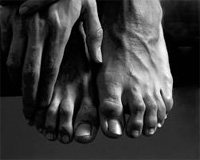 Your feet can tell you more about your overall health than you think. Your feet often show symptoms of disease or problems before any other part of your body.
Your feet can tell you more about your overall health than you think. Your feet often show symptoms of disease or problems before any other part of your body.
Hairless Toes
No hair on your feet can indicate poor circulation as a result of vascular disease. See a doctor about improving your circulation and getting your vascular health in check.
A Sore That Won’t Go Away
Sores on your feet that just don’t heal can indicate that you are at risk for diabetes. Elevated blood glucose levels over time can lead to nerve damage in the feet, so you might not even feel an ulcer on the bottom of your foot. Check your feet because if untreated, this can lead to serious consequences, including amputation.
Cold Feet
Women in particular experience cold feet. It could be nothing but it could also be a sign of an “underfunctioning” thyroid problem, which is the gland that regulates temperature and metabolism. Poor circulation is another possible cause for both men and women.
Foot Cramps
Foot cramps (charley horses) can be triggered by exercise or dehydration. However , if they occur frequently it could mean your diet lacks sufficient calcium, potassium, or magnesium. Pregnant women in the third trimester are especially vulnerable due to increased blood volume and reduced circulation to the feet.
Flexing the foot and gentle massage can help. Stretching gently before bed may help prevent cramps.
Thick Yellow Toenails
A toenail that has thickened, changed color, and separated from the skin, is probably a sign that you have a fungal infection beneath the toenail. By the time it has become visibly unattractive, the infection is advanced enough to spread to all your toenails and even fingernails. People with diabetes, rheumatoid arthritis, and other immune deficiencies may be more susceptible than others in contracting toenail fungus. See a foot specialist or your regular physician for care and treatment.
Big Toe Gets Bigger
Gout could be the reason behind a big toe that suddenly becomes enlarged. Though often thought of as an senior disease you don’t have to be over 65 to get it. It is actually a form of arthritis and is caused by the build up of the natural substance, uric acid.
The uric acid builds up and forms needle-like crystals in the body part with the lowest temperature… your big toe. Gout can also occur in the instep of your foot, your Achilles tendon, knees, and your elbows.
Shooting Pain In The Heel
If you experience a shooting pain in your heel it might be a sign of plantar fasciitis – which means the band of connective tissue running along the bottom of your foot is inflamed. The pain starts with your first steps in the morning and often intensifies throughout the day.
Source: Caring.com
